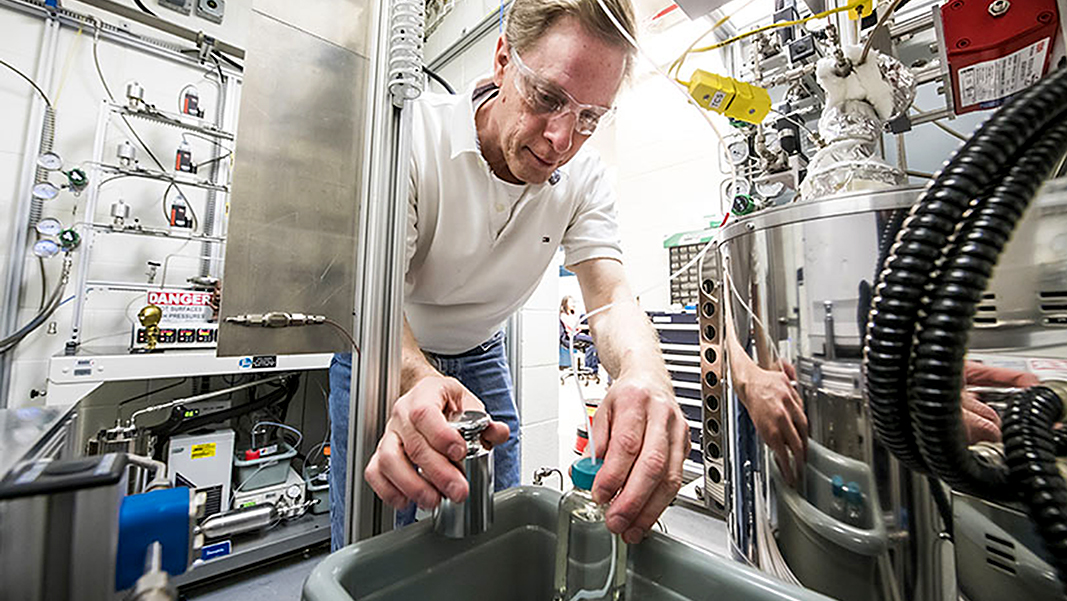Top: NREL’s formula for SAF from wet waste is compatible with existing jet engines, making it a promising candidate for quickly getting approved by ASTM International. Photo by Dennis Schroeder, NREL
Prior to the pandemic, upwards of 18 billion gallons of jet fuel were being consumed by U.S. airlines. According to U.S. EPA data, aircraft contribute 12% of U.S. transportation emissions, and account for 3% of the nation’s total greenhouse gas (GHG) production. These realities have fueled research into SAF, or sustainable aviation fuel. Scientists at the National Renewable Energy Laboratory (NREL) are among the researchers. They recently published an article in the proceedings of the National Academy of Sciences (NAS) that outlines a biorefining process using the untapped energy of food waste and other wet waste to produce SAF that is both compatible with existing jet engines and capable of supporting net-zero-carbon flight. NREL reports that a 165% drop in net carbon emissions compared to fossil jet fuel is achievable by targeting the significant GHG footprint of food waste — a documented source of methane emissions when disposed in landfills.
The abstract of the article in the NAS proceedings provides a technical description of what the NREL researchers achieved: “Wet waste is a low-cost, prevalent feedstock with the energy potential to displace over 20% of U.S. jet fuel consumption; however, its complexity and high moisture typically relegates its use to methane production from anaerobic digestion. To overcome this, methanogenesis can be arrested during fermentation to instead produce C2 to C8 volatile fatty acids (VFA) for catalytic upgrading to SAF. Here, we evaluate the catalytic conversion of food waste–derived VFAs to produce n-paraffin SAF for near-term use as a 10 vol% [10% by volume] blend for ASTM ‘Fast Track’ qualification and produce a highly branched, isoparaffin VFA-SAF to increase the renewable blend limit. VFA ketonization models assessed the carbon chain length distributions suitable for each VFA-SAF conversion pathway, and food waste-derived VFA ketonization was demonstrated for >100 hours of time on stream at approximately theoretical yield. Fuel property blending models and experimental testing determined normal paraffin VFA-SAF meets 10 vol% fuel specifications for ‘Fast Track.’”
Previous research showed how to interrupt methane generation with fermenters that transform the carbon energy of food waste and other organic “wet waste” into VFAs, which can be upgraded into jet fuel, notes an NREL article on the Lab’s SAF developments. But NREL says those studies, while proving that SAF from wet waste is possible, did not document how such fuel could meet ASTM International’s fuel property requirements. “Meeting ASTM standards is mandatory for the use and deployment of new SAF by industry,” NREL scientist Derek Vardon said in the article. “Our paper shows we can make drop-in SAF that meets those standards, with analysis that reveals how to refine VFAs so airlines can utilize large amounts of VFA-SAF without sacrificing performance.”
Using higher amounts of SAF in jet engines requires more time to be approved, but doing so can also enable much larger reductions in net emissions. “To provide a pathway for getting ASTM approval for higher blends, the paper outlines an extra step to produce more complex molecules called isoparaffins, which can have unique branched chemical structures,” explains NREL. “With more testing, SAF made from a combination of renewable isoparaffins and straight-chain paraffins could be blended with conventional jet fuel in higher concentrations, up to 70%.” Large aviation companies, including Southwest Airlines, are already collaborating with NREL and other organizations on the U.S. Department of Energy’s wet waste flight demonstration project.













